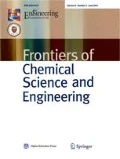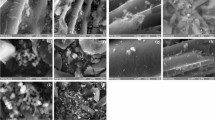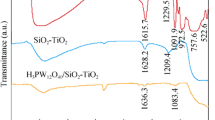Abstract
To realize the utilization of visible light and improve the photocatalytic efficiency of organic pollutant degradation in wastewater, a nitrogen-doped titanium-carbon composite (N-TiO2/AC) prepared by sol-gel methods was applied in the photodegradation of phenol assisted by persulfate under visible light irradiation (named N-TiO2/AC/PS/VIS). The results show that a synergistic effect exists between visible-light photocatalysis and persulfate activation. Compared with TiO2/PS/VIS, the phenol degradation rate was found to be observably improved by 65% in the N-TiO2/AC/PS/VIS system. This significant increase in degradation rate was mainly attributed to the following two factors: 1) The N and C doping can change the crystal structure of TiO2, which extends the TiO2 absorption wavelength range to the visible light region. 2) As an electron acceptor, PS can not only prevent electrons and holes from recombining with each other but can also generate strong oxidizing radicals such as ·SO4− and ·OH to accelerate the reaction dynamics. The process of phenol degradation was found to be consistent with the Langmuir pseudo-first-order kinetic model with an apparent rate constant k of 1.73 min−1. The N-TiO2/AC/PS/VIS process was proven to be a facile method for pollutant degradation with high pH adaptability, excellent visible-light utilization and good application prospects.

Similar content being viewed by others
References
Lu J W, Lan L, Liu X T T, Wang N, Fan X L. Plasmonic Au nanoparticles supported on both sides of TiO2 hollow spheres for maximising photocatalytic activity under visible light. Frontiers of Chemical Science and Engineering, 2019, 13(4): 665–671
Zhang T H, Liu Y J, Rao Y D, Li X P, Yuan D L, Tang S F, Zhao Q X. Enhanced photocatalytic activity of TiO2 with acetylene black and persulfate for degradation of tetracycline hydrochloride under visible light. Chemical Engineering Journal, 2020, 384: 123350
Yang L, Xu L, Bai X, Jin P. Enhanced visible-light activation of persulfate by Ti3+ self-doped TiO2/graphene nanocomposite for the rapid and efficient degradation of micropollutants in water. Journal of Hazardous Materials, 2019, 365: 107–117
Grilla E, Matthaiou V, Frontistis Z, Oller I, Polo I, Malato S, Mantzavinos D. Degradation of antibiotic trimethoprim by the combined action of sunlight, TiO2 and persulfate: a pilot plant study. Catalysis Today, 2019, 328: 216–222
He L, Dong Y N, Zheng Y N, Jia Q M, Shan S Y, Zhang Y Q. A novel magnetic MIL-101(Fe)/TiO2 composite for photo degradation of tetracycline under solar light. Journal of Hazardous Materials, 2019, 361: 85–94
Hou L Q, Yang W, Xu X W, Deng B J, Chen Z, Wang S, Tian J B, Yang F, Li Y F. In-situ activation endows the integrated Fe3C/Fe@ nitrogen-doped carbon hybrids with enhanced pseudocapacitance for electrochemical energy storage. Chemical Engineering Journal, 2019, 375: 10
Kakavandi B, Bahari N, Kalantary R R, Fard E D. Enhanced sono-photocatalysis of tetracycline antibiotic using TiO2 decorated on magnetic activated carbon (MAC@T) coupled with US and UV: a new hybrid system. Ultrasonics Sonochemistry, 2019, 55: 75–85
Liu D D, Wu Z S, Tian F, Ye B C, Tong Y B. Synthesis of N and La co-doped TiO2/AC photocatalyst by microwave irradiation for the photocatalytic degradation of naphthalene. Journal of Alloys and Compounds, 2016, 676: 489–498
Yang X L, Qian F F, Wang Y, Li M L, Lu J R, Li Y M, Bao M T. Constructing a novel ternary composite (C16H33(CH3)3N)4W10O32/g-C3N4/rGO with enhanced visible-light-driven photocatalytic activity for degradation of dyes and phenol. Applied Catalysis B: Environmental, 2017, 200: 283–296
Asahi R, Morikawa T, Ohwaki T, Aoki K, Taga Y. Visible-light photocatalysis in nitrogen-doped titanium oxides. Science, 2001, 293(5528): 269–271
Hoang S, Berglund S P, Hahn N T, Bard A J, Mullins C B. Enhancing visible light photo-oxidation of water with TiO2 nanowire arrays via cotreatment with H2 and NH3: synergistic effects between Ti3+ and N. Journal of the American Chemical Society, 2012, 134(8): 3659–3662
Martins A C, Cazetta A L, Pezoti O, Souza J R B, Zhang T, Pilau E J, Asefa T, Almeida V C. Sol-gel synthesis of new TiO2/activated carbon photocatalyst and its application for degradation of tetracycline. Ceramics International, 2017, 43(5): 4411–4418
Rimoldi L, Pargoletti E, Meroni D, Falletta E, Cerrato G, Turco F, Cappelletti G. Concurrent role of metal (Sn, Zn) and N species in enhancing the photocatalytic activity of TiO2 under solar light. Catalysis Today, 2018, 313: 40–46
Park J H, Kim S, Bard A J. Novel carbon-doped TiO2 nanotube arrays with high aspect ratios for efficient solar water splitting. Nano Letters, 2006, 6(1): 24–28
Wang H, Lewis J P. Effects of dopant states on photoactivity in carbon-doped TiO2. Journal of Physics Condensed Matter, 2005, 17 (21): 209–213
Wang C, Jia S Y, Zhang Y C, Nian Y, Wang Y, Han Y, Liu Y, Ren H T, Wu S H, Yao K X, Han X. Catalytic reactivity of Co3O4 with different facets in the hydrogen abstraction of phenol by persulfate. Applied Catalysis B: Environmental, 2020, 270: 12
Sanches S, Crespo M T B, Pereira V J. Drinking water treatment of priority pesticides using low pressure UV photolysis and advanced oxidation processes. Water Research, 2010, 44(6): 1809–1818
Chiou C H, Wu C Y, Juang R S. Influence of operating parameters on photocatalytic degradation of phenol in UV/TiO2 process. Chemical Engineering Journal, 2008, 139(2): 322–329
Dominguez J R, Beltran J, Rodriguez O. Vis and UV photocatalytic detoxification methods (using TiO2,TiO2/H2O2,TiO2/O3,TiO2/S2O82−,O3,H2O2,S2O82−,Fe3+/H2O2 and Fe3+/H2O2/C2O42−) for dyes treatment. Catalysis Today, 2005, 101(3–4): 389–395
Garcia J C, Oliveira U, Silva A E C, Oliveira C C, Nozaki J, de Souza N E. Comparative study of the degradation of real textile effluents by photocatalytic reactions involving UV/TiO2/H2O2 and UV/Fe2+/H2O2 systems. Journal of Hazardous Materials, 2007, 147 (1–2): 105–110
Harir M, Gaspar A, Kanawati B, Fekete A, Frommberger M, Martens D, Kettrup A, El Azzouzi M, Schmitt-Kopplin P. Photocatalytic reactions of imazamox at TiO2,H2O2 and TiO2/H2O2 in water interfaces: kinetic and photoproducts study. Applied Catalysis B: Environmental, 2008, 84(3–4): 524–532
Hazime R, Nguyen Q H, Ferronato C, Salvador A, Jaber F, Chovelon J M. Comparative study of imazalil degradation in three systems: UV/TiO2, UV/K2S2O8 and UV/TiO2/K2S2O8. Applied Catalysis B: Environmental, 2014, 144: 286–291
Momenia M M, Hosseini M G. Photo-electrocatalytic activity of TiO2 nanotubes prepared with two-step anodization and treated under UV light irradiation. Nanochemistry Research, 2016, 1(1): 9–18
Liu G S, You S J, Tan Y, Ren N Q. In situ photochemical activation of sulfate for enhanced degradation of organic pollutants in water. Environmental Science & Technology, 2017, 51(4): 2339–2346
Ahmed B, Anjum D H, Hedhili M N, Gogotsi Y, Alshareef H N. H2O2 assisted room temperature oxidation of Ti2C MXene for Li-ion battery anodes. Nanoscale, 2016, 8(14): 7580–7587
Lewin E, Persson P O A, Lattemann M, Stuber M, Gorgoi M, Sandell A, Ziebert C, Schadfers F, Braun W, Halbritter J, et al. On the origin of a third spectral component of C1s XPS-spectra for nc-TiC/a-C nanocomposite thin films. Surface and Coatings Technology, 2008, 202(15): 3563–3570
Kodtharin N, Vongwatthaporn R, Nutariya J, Sricheewin C, Timah E N, Sivaleitporn K, Thumthana O, Tipparach U. Structures and properties of N-doped TiO2 nanotubes arrays synthesized by the anodization method for hydrogen production. Materials Today: Proceedings, 2018, 5(6): 14091–14098
Soto G. AES, EELS and XPS characterization of Ti(C, N, O) films prepared by PLD using a Ti target in N2,CH4,O2 and CO as reactive gases. Applied Surface Science, 2004, 233(1/4): 115–122
Huang H S, Song Y, Li N J, Chen D Y, Xu Q F, Li H, He J H, Lu J M. One-step in-situ preparation of N-doped TiO2@C derived from Ti3C2 MXene for enhanced visible-light driven photodegradation. Applied Catalysis B: Environmental, 2019, 251: 154–161
Li H, Hao Y, Lu H, Liang L, Wang Y, Qiu J, Shi X, Wang Y, Yao J. A systematic study on visible-light N-doped TiO2 photocatalyst obtained from ethylenediamine by sol-gel method. Applied Surface Science, 2015, 344: 112–118
Liu X F, Xing Z P, Zhang Y, Li Z Z, Wu X Y, Tan S Y, Yu X J, Zhu Q, Zhou W. Fabrication of 3D flower-like black N-TiO2x@MoS2 for unprecedented-high visible-light-driven photocatalytic performance. Applied Catalysis B: Environmental, 2017, 201: 119–127
Chen X Y, Wang W P, Xiao H, Hong C L, Zhu F X, Yao Y L, Xue Z Y. Accelerated TiO2 photocatalytic degradation of acid orange 7 under visible light mediated by peroxymonosulfate. Chemical Engineering Journal, 2012, 193: 290 295
Guo Y, Zeng Z, Liu Y, Huang Z, Cui Y, Yang J. One-pot synthesis of sulfur doped activated carbon as a superior metal-free catalyst for the adsorption and catalytic oxidation of aqueous organics. Journal of Materials Chemistry. A, Materials for Energy and Sustainability, 2018, 6(9): 4055–4067
Guo Y, Zeng Z, Zhu Y, Huang Z, Cui Y, Yang J. Catalytic oxidation of aqueous organic contaminants by persulfate activated with sulfur-doped hierarchically porous carbon derived from thiophene. Applied Catalysis B: Environmental, 2018, 220: 635–644
Gao Y W, Li S M, Li Y X, Yao L Y, Zhang H. Accelerated photocatalytic degradation of organic pollutant over metal-organic framework MIL-53(Fe) under visible LED light mediated by persulfate. Applied Catalysis B: Environmental, 2017, 202: 165–174
Duan X G, Sun H Q, Wang Y X, Kang J, Wang S B. N-Doping-induced nonradical reaction on single-walled carbon nanotubes for catalytic phenol oxidation. ACS Catalysis, 2015, 5(2): 553–559
Li X, Liao F, Ye L, Yeh L. Controlled pyrolysis of MIL-88A to prepare iron/carbon composites for synergistic persulfate oxidation of phenol: catalytic performance and mechanism. Journal of Hazardous Materials, 2020, 398: 122938
Acknowledgements
The authors gratefully acknowledge the financial support from the Youth Scientific and Technological Foundation of Shanxi Province (Grant No. 201701D221232) and the Youth Scientific and Technological Foundation of Shanxi Province (Grant No. 201901D211580).
Author information
Authors and Affiliations
Corresponding authors
Rights and permissions
About this article
Cite this article
Cui, Y., Zeng, Z., Zheng, J. et al. Efficient photodegradation of phenol assisted by persulfate under visible light irradiation via a nitrogen-doped titanium-carbon composite. Front. Chem. Sci. Eng. 15, 1125–1133 (2021). https://doi.org/10.1007/s11705-020-2012-z
Received:
Accepted:
Published:
Issue Date:
DOI: https://doi.org/10.1007/s11705-020-2012-z




